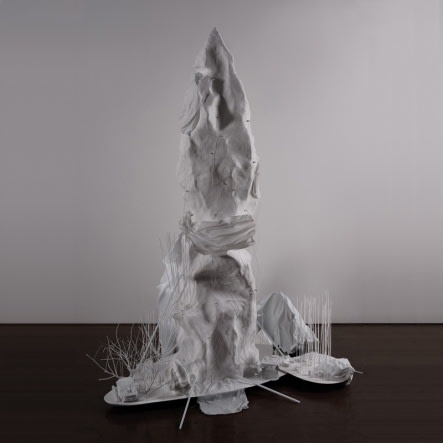Landscape Perceived
Title | Landscape Perceived
Artists | Hyounsoo Kyung, Hyuk Kwon, Myoungjin Song, Jeongbae Lee
Date | 2013 07 25(Thu) ~ 09 15(Sun)
Location | Arario Gallery, Seoul
Works | Painting, Drawing, photography, sculptures
Arario Gallery hosts a group exhibition entitled “Landscape Perceived” from July 25th to September 15th at Arario Gallery in Seoul, introducing artists – Hyunsoo Kyung, Hyuk Gwon, Myeong-jin Song, and Jeongbae Lee - who each produce unique forms of landscape from their own, special perspective. The four featured artists, active in the domestic and international art scenes, present landscape pieces that feature worlds perceived and cognized through diverse social relationships and subjective viewpoints.
From classic, realistic paintings to modern and contemporary art, landscapes have ceaselessly changed in the flow of new materials and trends. The details and perspectives change, depending on the artist’s subjective view, intention, and degree of intervention, resulting in a wide variety of forms ranging from abstraction, geometric precision to faithful realism. Especially, contemporary landscapes have reflected the artificial image of the urban space as an artistic habitat, harboring nature and people alike. Such variations are represented as “perceived ladscape” in this exhibition, connecting the viewers with different versions of the world as we see it.
Arario Gallery hosts a group exhibition entitled “Landscape Perceived” from July 25th to August 18th at Arario Gallery in Seoul, introducing artists – Hyunsoo Kyung, Hyuk Gwon, Myeong-jin Song, and Jeongbae Lee - who each produce unique forms of landscape from their own, special perspective. The four featured artists, active in the domestic and international art scenes, present landscape pieces that feature worlds perceived and cognized through diverse social relationships and subjective viewpoints. From classic, realistic paintings to modern and contemporary art, landscapes have ceaselessly changed in the flow of new materials and trends. The details and perspectives change, depending on the artist’s subjective view, intention, and degree of intervention, resulting in a wide variety of forms ranging from abstraction, geometric precision to faithful realism. Especially, contemporary landscapes have reflected the artificial image of the urban space as an artistic habitat, harboring nature and people alike. Such variations are represented as “perceived ladscape” in this exhibition, connecting the viewers with different versions of the world as we see it.
*Artists
Hyounsoo Kyung (b. 1969)
The Debris Division Series, newly introduced at this exhibition, falls in line with the themes the artist has been pursuing. The artist goes a step further from the previous Debris series, in which she deconstructs and restructures maps – objectified data of the city’s construct and various aspects. His new work, created by cutting up and reproducing the deconstructed images, appears to be maximizing impromptu amusement within space, but is in fact a combination of highly calculated, derived images. The images, produced through the artist’s new mechanism, are delightfully yet strangely entangled through the process of segmentation and amplification. We can no longer see traces of precise, objective data, which had been the root of his works. As if emphasizing the impossibility of finding novelty through reproduction, the images in his work shows free-floating imagination and playful consciousness.
Hyuk Gwon (b.1966)
Kwon Hyuk, an artist who works with strings on canvas using the stitch technique, draws landscapes focusing on water, an object arising from time she herself has experienced. To her, the strings are brushes, and the canvas is the cloth. The body of water, drawn with sewing machines on acryl colored canvas, continues to convene and disperse as the mother body that bears the energy of all substance. The water’s waves are metaphors of the artist’s perspective, expressed in the form of moving energy full of vitality people, animals, the mountains and the ocean emit. The invisible and voluntary energy, incontrollable, comes together with the coincidental strokes of stitches that flow on regardless of the artist’s will and create ample texture. The combination of the small stitched dots are collections of each drop of water, and the view of water that has been a critical part of our lives as the energy inherent in the essence of substance.
Myoungjin Song(b.1973)
The artist has been presenting works that emphasize flatness, filling the canvas with ambiguous forms that stimulate the viewers’ curiosity with opaque green as the main color theme. Her artistic world, unique in its structure, has been expanding the potential of painting by pulling together the flatness of drawings and the internal narrative of the painting. However, her recent works lack her signature green color, and are instead full of ambiguous colors that stand in between skin-like peach and two other colors. The forms on the canvas consist of basic shapes such as cylinders, holes and columns, minimized and simplified; the narrative is gone; and the spatial construct is a mixture of the two and three dimensional. However, these formations still lack a fixed frame, and take on a mediatory shape, constantly shifting. This form is the result of the artist’s ceaseless effort to intentionally avoid the illusory property of painting, and is an experimental attempt to highlight the flatness of drawing.
Jeongbae Lee (b.1974)
The motifs of the work, springing from black and white landscape, include the peaks and ridges of beautiful mountain tops such as Insu, Daecheung and Sulak. The ridges on the canvas naturally bleed over, creating an effort like traditional ink-paintings. However, the landscape is forcefully segmented and cut away from the overall flow of the ridge in the frames the artist intentionally inserts, and somewhere along the ridge, we see traces of human contact. The segmented peaks, the stone cliffs with someone’s name carved into it, the ridges cased in steel nets, and countless holes bored in for rock climbing – the artist calmly presents the vestiges of sadistic, artificial gestures. These features represent the artist’s indirect, reserved commentary on how mankind’s desire – to see Nature more as an object of maneuver than a being that encompasses human existence as such – is expressed in the landscape.












































